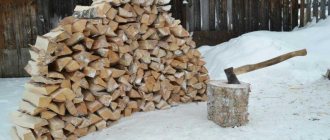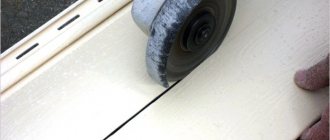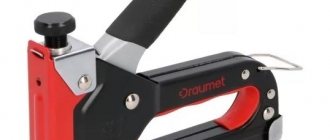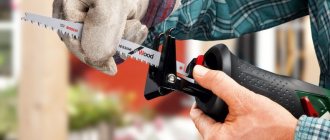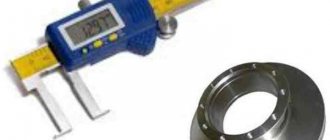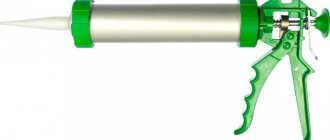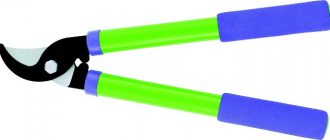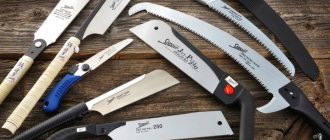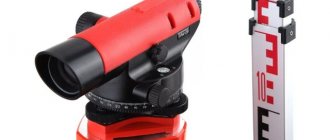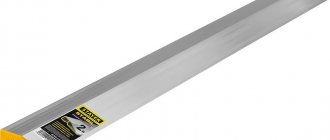Purpose and principle of operation of the miter box
A miter box is a common carpentry tool that is used for precise cutting of straight workpieces at angles.
The simplest option allows you to cut vertically at 90°, 60° and 45° and horizontally at 45°, since these angles are the most common when carrying out construction and repair tasks.
But there are models that allow you to cut material at any angle.
This tool is often used for:
• Formation of joining corners of the plinth;
• Cutting glazing beads, baguettes, door frames;
• Sawing boards;
• Sawing slats from various materials, including metal and plastic.
Direct purpose of the tool:
• Sawing at right angles relative to the horizontal and vertical axis;
• Formation of the internal corner of the connected elements;
• Formation of the outer corner.
Using the tool, it is possible to produce frames and various decorative elements, since it is a kind of template.
Main purposes of a rotary miter box
A miter box is a tool used to cut workpieces at the required angle. The simple version of this tool performs vertical or horizontal cuts only at common angles: 45o, 60o, 90o, and the rotary one allows you to adjust any cutting angle. In many carpentry workshops it is an indispensable tool for highly complex work.
It consists of an adjustable stand and a sharp saw, used for sawing:
- Skirting boards.
- Door frames.
- Boards
- Framework.
- Decor elements.
- Rails made of metal or plastic.
- The inner or outer corner of the parts being connected.
They can perform jobs that hacksaws and circular saws cannot handle.
Device and characteristics
The simplest miter box is a tray, the sides of which have cuts for the saw blade, made at common angles relative to the base.
Professional models include a rotary tool that allows you to cut workpieces at any angle with an accuracy of 1 degree.
The structure consists of a base and a rotating part. A guide element is provided for fixing the hacksaw.
Material
In the production of tools, materials with sufficient rigidity are used.
In a hardware store, a buyer most often encounters the following options:
• Wooden – it is rigid and ensures cutting accuracy.
The most common product is made from beech, since this wood has high strength indicators.
The cost starts at 500 rubles.
A homemade tool for infrequent use can be made from plywood within an hour, but it will not last very long.
• Plastic - a common option due to the low cost of 100 - 200 rubles.
The hollow structure of the plastic miter box has a wall thickness of about 1 mm.
The strength of the material is low, which means that the grooves are quickly ground down under the action of the saw teeth.
• Metal.
A characteristic feature is the presence of quick-release clamps for holding workpieces.
There are mainly aluminum miter boxes on the market, which are distinguished by their reliability and durability.
Dimensions and weight of the miter box
Depending on the material and size, the average weight of a classic tool in the form of a tray is from 0.1 to 0.6 kg.
Rotary options weigh 2 – 4 kg.
Average dimensions (LxWxH) of a U-shaped miter box:
• Small: 212x44x42 mm. WxH cut – 35x35mm.
• Average: 290x85x50 mm. WxH cut – 65x40 mm.
• Large: 320x125x70 mm. WxH cut – 90x55 mm.
Dimensions given are approximate only.
The length of most models of classical instruments is in the range of 290 – 310 mm.
There are also tall miter boxes, in which the height is slightly greater than the width.
In this case, to increase stability, manufacturers make the base wider than the tray itself, and predominantly aluminum is used in manufacturing.
Types of miter box
Like any tools, the miter box differs in appearance between improved and ordinary models. The design and material used for sawing workpieces vary. The most common are products made of wood and plastic. Miter box miter saws are classified according to the complexity of the mechanism into types:
- simple;
- rotary;
- electric.
Simple miter box
The most popular type of tool for sawing workpieces is a simple miter box, which is used by home craftsmen for repair work. It looks like a box with holes located at certain angles into which a hacksaw is inserted. Templates can be added independently, but the presence of angles of 45 and 90° is considered mandatory for any miter box. The advantages of such a device are its budget cost, accessible to any specialist, but the disadvantages of the tool are considered to be:
- limitation of the width of workpieces;
- imperfection of the cut;
- limited number of templates;
- Getting a quality cut requires skill.
Rotary miter box
For work that requires high measurement accuracy, specialists use a rotary tool, which is also called a precision miter box; its mechanism allows you to cut the material at different angles, the value of which can range from 15 to 135°. The device consists of a stable stand, a bed and a locking saw. Notches are made at the bottom of the platform to accurately set the cutting angle. The cost of a rotary miter box is higher than simple models; its features include:
- convenient base, suitable for any materials - wood, metal and plastic;
- cutting accuracy;
- large blade travel;
- regulation of cutting depth and other parameters;
- high quality cut.
Types of miter boxes and their prices
The variety of tool shapes is dictated by the wide range of tasks for which it is used.
Traditional products are divided into 2 types:
Normal
A classic instrument that is easy to make yourself.
It is based on a U-shaped profile made of wood, plastic or metal.
This product is also called box-shaped due to its shape.
The template type of the device excludes the possibility of adjustments, which means that cuts are made along structurally laid slots.
Their number, as a rule, does not exceed 7 pieces, and includes the most common angles (30°, 45°, 60° in both directions and in the center at 90°).
Cost 150 – 500 rubles (up to 1000 rubles if the kit includes a saw).
Rotary
Another name is precision.
Its special feature is the ability to adjust any cutting angle.
Most models allow you to adjust the required angle in two planes.
The set consists of a saw and an adjustable stand.
The main advantage is the ability of the cutting element to enter the material at angles other than straight, simultaneously vertically and horizontally, which makes such a tool biplane.
This allows you to form a bevel at the end of a workpiece of any configuration.
This type of miter box is professional and indispensable for highly complex carpentry work.
The price starts from 2 thousand rubles.
Electrical
In addition to the listed manual types, there is an electric miter box - a sawing power tool with the ability to work at different angles.
The most common miter saw is the one with an adjustable stand.
A miter box installed on a power tool allows you to perform the same type of precise cut at angles on an almost industrial scale.
For forming end surfaces of complex shapes, there are less common options, for example, for sawing dovetail or comb joints.
The dimensions of such models, compared to conventional products, are much smaller.
They act as a template that is installed on the surface of the workpiece in the place where the groove or tenon is cut.
Universal
Another less common type of miter box looks like a frame on which two interconnected disks are attached, forming guides.
The saw blade is inserted between them. The angle is adjustable in two planes.
This tool requires preliminary configuration and is less convenient.
Magnetic miter box
A tool that uses magnets to hold the hacksaw blade at a specific angle.
They vary in purpose, appearance and ease of use.
For example, one of the options is an adjustable square with magnets located on both sides.
It is extremely compact.
The cost is around 400 rubles.
The tool can be equipped with additional elements or functions that increase ease of use:
- With lock. As a rule, these are one or more movable clamps integrated into the body.
- With eccentrics. In the horizontal platform (base) of the U-shaped miter box there are many holes into which fingers with eccentric tips resembling a rounded wedge are inserted. When turning, the workpiece is pressed against the side, ensuring reliable fixation.
- With a tilt of the canvas. A tool with a saw, the angle of inclination of the blade can vary relative to the horizontal. This includes some models of power miter saws and rotary miter boxes.
Many manufacturers offer kits that include a hacksaw with a U-shaped miter box.
The set and features of the teeth of the cutting tool are selected in accordance with the grooves of the template.
What is a miter box for?
Plastic pipes, slats, baseboards, and decorative items may need to be joined together by cutting at an angle. A narrow miter box for skirting boards is used to form an ideal angle; it is convenient to use for cutting baguettes and glazing beads. Using a miter box, you can saw wood, plastic and metal products. It is believed that the device is used for the following work:
- forming a rectangular cut relative to the horizontal or vertical;
- manufacturing various corner elements according to a template.
Which miter box is better and how to choose it?
A simple U-shaped tool for cutting material at common angles is suitable for home use.
This miter box will cope with common tasks, such as adjusting ceiling and floor skirting boards and trim.
Professional carpentry requires options that allow you to cut workpieces at all possible angles.
Precision two-plane tools do this job well.
When choosing, you should pay attention to:
- Material and wall thickness. The best option is wood or metal due to its strength and wear resistance.
- The maximum width and height of the cut are selected individually in accordance with the dimensions of the workpieces.
- The presence of a saw in the kit is a prerequisite for performing a high-quality cut. A good cutting tool is equipped with a backing, the dimensions of the saw blade are adjusted to the grooves.
- Move. The movement of the saw should be free, but any backlash should be eliminated.
- Availability of clamps. They will allow you to securely fasten the workpiece, eliminating the need to hold it with your hands.
- Number of corners (for U-shaped) - the more there are, in addition to the common ones, the better.
It should be remembered that a high-quality miter box must have clearly visible markings on the corners.
What is the miter box made of?
Manufacturers use a variety of materials to make carpentry fixtures. A hand miter box is a simple tool made from durable, shock- and damage-resistant materials. Box-shaped universal models, which can be found in any construction supermarkets, are made of:
- wood;
- plastic;
- metal
Wooden miter box
The simplest design of a miter box is made of hard wood. Beech is most suitable for the parameters of the device; this type of wood is highly durable. A mechanical miter box made of wood is a rigid structure that guarantees precise sawing of the material. At home, you can use plywood to make it yourself, but such a tool will not be of high quality and durable. The main advantage of such a tool is its low cost.
Plastic miter box
Devices made of plastic are of low quality. Even expensive, durable synthetic material loses its properties under the influence of saw teeth. The grooves quickly wear off on such a tool, and the miter box breaks down after a few uses, and the quality of sawing becomes worse. Even an extra millimeter can ruin the finished result. Fragility is the main drawback of the device for cutting plastic workpieces. Its advantages are light weight and mobility.
Metal miter box
Tools for sawing workpieces made of light but durable metal are considered the most popular on the market. An aluminum miter box is a reliable and durable tool that will faithfully serve the home craftsman for a long time. The simplest device has the form of a U-shaped profile, in which slots are made at certain angles; adjustment is not provided for in such models. Lightweight budget models of miter boxes can be carried in a work bag and confidently used for a long time.
What you need to know about the miter box?
To perform a specific type of work, something like a miter box is often made, where only one seat is modeled for the task.
Such options include a tool, for example, for cutting soap.
Convenience of work increases with marking, and the cut can be not only straight, but also curly.
To work with specific types of miter boxes, a special hacksaw is required.
However, this does not mean that you cannot use any other sawing tool.
The difference is that in the second case the cut will not be as smooth and clean.
As for the special saw supplied with the miter box, it has a backing that prevents the blade from bending and at the same time acts as a depth limiter.
You can replace it with a hand hacksaw or a bow saw with a medium-sized tooth.
Cheap miter saw or expensive precision miter box?
Gentlemen, please advise. I searched everything, but I didn’t come across exactly this formulation of the question. But I can’t decide myself, because I’ve never held these devices in my hands.
So, after renovation, you need to upholster your apartment with a plastic baseboard with a cable channel. Not a “regular” one with a pull-out central insert, but a high (86 mm) rigid one, where the “outer” part snaps onto a “cable-base” fixed to the wall (I hope I was able to explain). You don’t want to see stupid branded connecting corners, and the trouble is that the apartment is stuffed with bay windows and, accordingly, angles other than 90 degrees. Preliminary estimates say that about 80 cuts will have to be made. Well, I’m still resisting, but I’ll probably have to give in and make a ceiling plinth in one room: 13 corners, only four of which are 90 degrees.
Three options are obvious: call the golden guys through an ad or do it yourself using some tool from the topic title. The golden guys will cost the most, and the process itself will probably be somewhat extended in time. For a week, for example. Therefore, you need to do it yourself.
An expensive miter box costs about 4-5-6 thousand rubles. Cheap trimming costs the same. Well, plus, let’s say you suddenly need a more polished disk instead of a standard one. But still, the numbers are comparable. Here are 17-20 thousand (where all sorts of Makitas start) - this is already unreasonable for an obviously one-time job. That is, I don’t need resources, durability, 100-year guarantees, lasers and all that. Inconvenience in operation (which does not lead to a decrease in the quality of the saw) can also be tolerated. I don’t care what happens to the saw after installing the skirting boards. If it doesn’t break, that’s good; if it breaks after the last cut, that’s even better (it won’t take up space in the house).
The bottom line (for those who were too lazy to read everything. Sorry for the many letters): does it make sense to buy a cheap Chinese miter cutter for a one-time job for about 100 cuts (well, plus another 50 training ones, for example)? The only thing of interest is the accuracy of the cut, that is, the absence of gaps in the joints. Or are there such tolerances and gaps that to achieve the result it makes sense to puff on an expensive rotary miter box? If I were to cut what kind of boards for a bathhouse (where accuracy is not of concern) I wouldn’t think twice about it. But here, precision and cleanliness of the cut are extremely important. In general, we need simple everyday advice - which unit would a master take for this job if it was free (or equal price) and both were available?
Thank you.
How to use a miter box?
Brief instructions for using the tool:
• The tool is attached to the work table with clamps or self-tapping screws.
• The workpiece is marked, after which it is placed in the tray.
• Once in place, the workpiece is pressed against one of the sides in such a way as to align the mark with the required groove.
• The hacksaw blade is inserted into the grooves, after which you can begin cutting the workpiece.
NOTE:
To form high-precision cuts, you should use a special hacksaw equipped with a spine.
What to especially pay attention to
When choosing a precision miter box, special attention must be paid to the material of manufacture. As a rule, well-known and reliable brands make this device from high-strength materials. A metal tool or made of ABS plastic is highly reliable and durable, as well as increased resistance to external mechanical influences and shocks. In addition, the device can be made of aluminum or combined materials, which makes it even more reliable and at the same time lightweight.
Safety precautions
When working with a hacksaw using a miter box, it is advisable to use thick gloves and safety glasses to prevent sawdust from getting into your eyes.
The tool must be fixed on the desktop.
If it is not equipped with any clamps, the workpiece is held in the required position by hand.
To do this, at a safe distance from the groove with the inserted saw, the thumb rests on the material being cut, presses it against the side of the miter box, and the remaining fingers clasp this same side.
When starting a cut, the saw should be inserted into the grooves at least to the height of the teeth.
Marking with a canvas is carried out with slow, even movements, which will protect the master from jumping out of the groove.
Precision rotary and inclined professional miter box 550 - 600 mm.
Working with such a tool is a pleasure, but quite expensive. Therefore, if performing such work is not your main income, we advise you to turn your attention to a manual miter box, almost an analogue of an electric miter box - a precision rotary-tilt professional miter box from 550 to 600 mm.
The work on it can be done almost the same as on its electric counterpart. At the same time, the accuracy and cutting characteristics are not inferior to it. Let's take a closer look at this tool.
Quite a few manufacturers of hand tools have in their assortment precision rotary-tilt miter boxes with almost similar characteristics, so when choosing, focus on the authority of a particular company or brand, rather than on technical characteristics.
Video on the topic
Precision miter box
with saw - description
There are not so many fundamental differences between similar tools of different brands, and first of all they relate to the materials from which the main parts of the device are made. First of all, pay attention to the frame on which both the saw itself is mounted in the guides on the rotary unit, and the workpiece. There are two options for its execution: cast metal and plastic. If you are going to perform most of the operations in this miter box with large, heavy parts, then give preference to an aluminum body, and if you are cutting polystyrene foam or polyurethane foam baguettes on it, give preference to a plastic one.
The next fundamental point that you should pay attention to first is the small plastic parts. It is they, if you don’t hit the miter box with a sledgehammer (of course, figuratively speaking), that will fail first. Here we advise you to pay attention not only to the quality of the plastic, but also to the difficulty of making the element yourself in the future, perhaps even from a different material. The easiest way to do this is when the miter box is not yet assembled.
The abundance of options for technical solutions in the designs of precision rotary miter boxes will allow you to choose a tool with the simplest details.
If you are a neat person and will work with this tool yourself, then pay special attention to the rotary and inclined units. Here you should make sure that the saw is accurately and, most importantly, clearly fixed at a given angle.
In general, the less play in the entire structure, the better, so when choosing a precision rotary miter box, ask to show you all those available at the same time and choose the one that your hand will feel better. But for myself personally, I chose a purely rotary option - a complex angle is not so difficult to complete in 2 cuts, and the design is much more reliable.
It remains to say a few words about hacksaw blades. Choose expensive, super alloy steel only if you are going to work with the appropriate materials. If you are trimming soft wood and even softer plastic or ceiling plinths, you shouldn’t waste your money. In this case: the best canvas is new.
We recommend other articles on the topic
